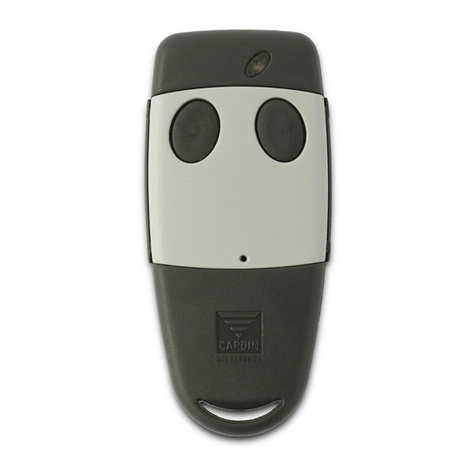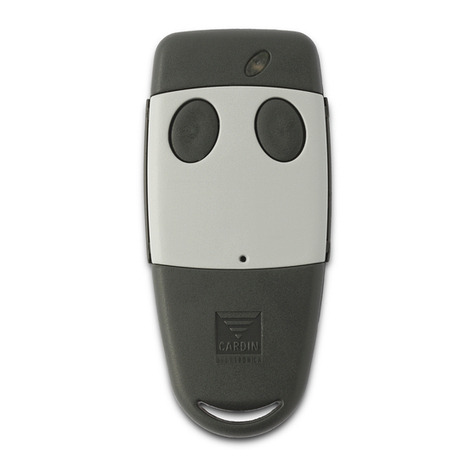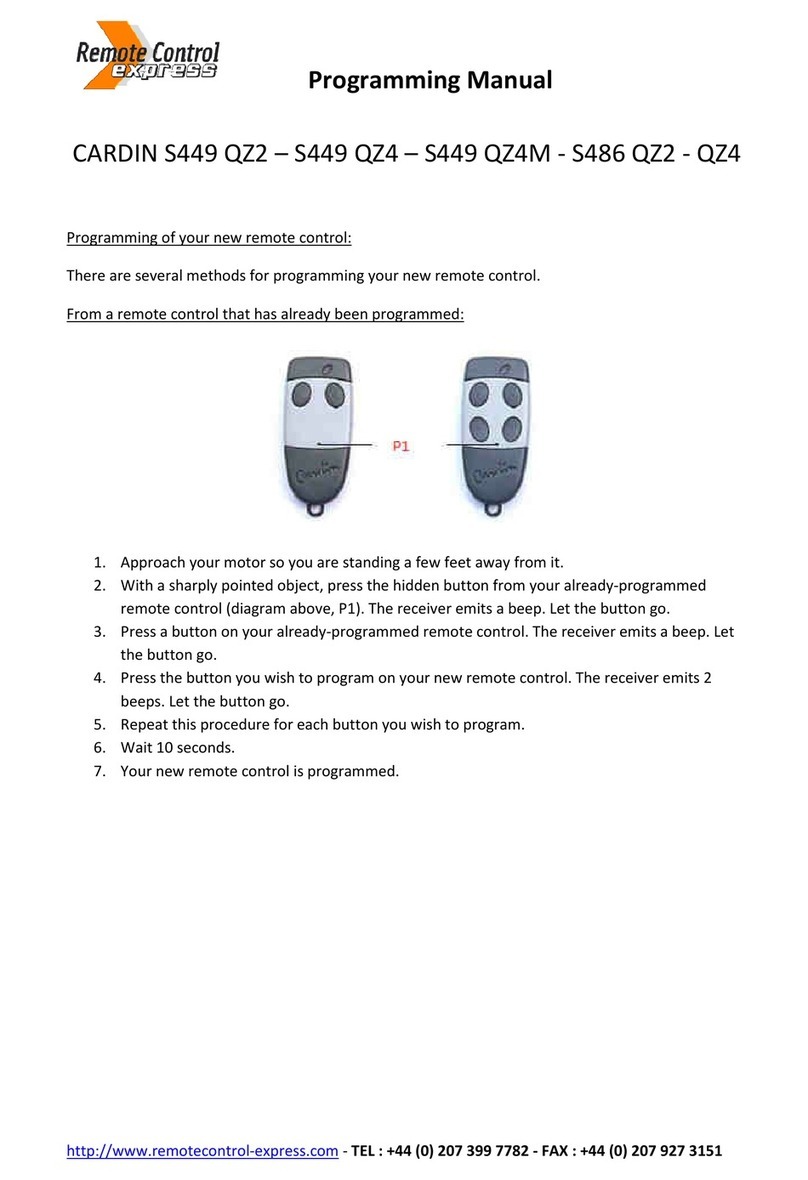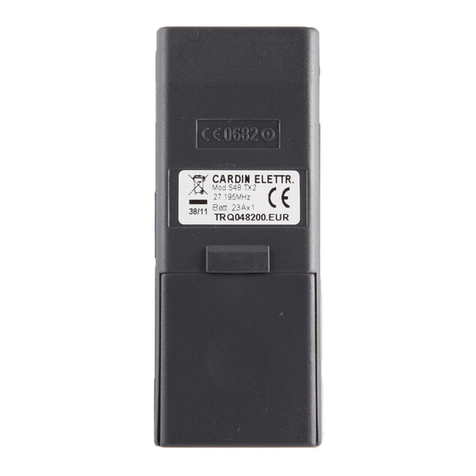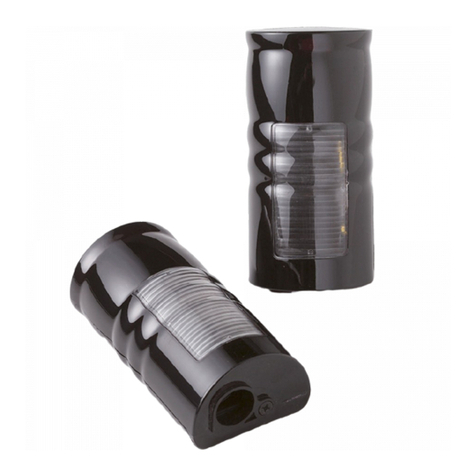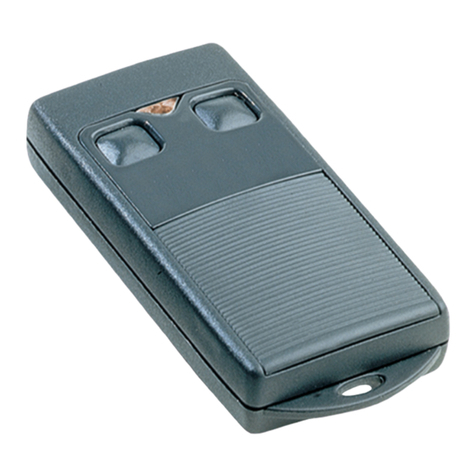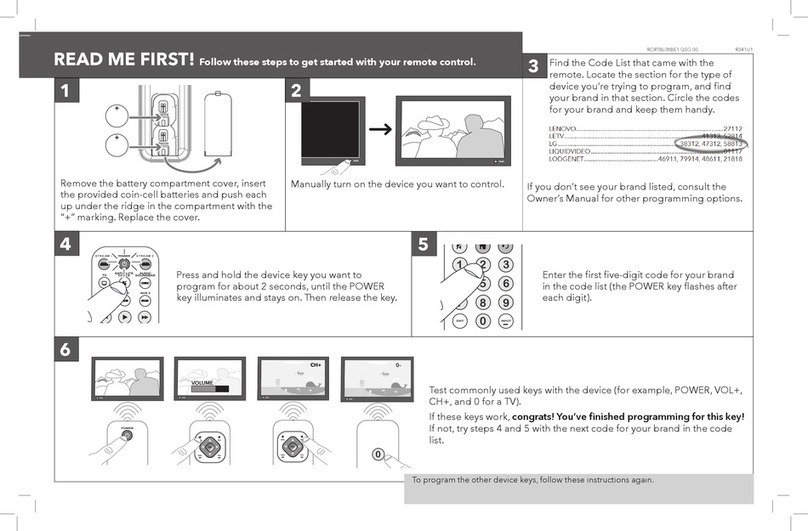
S435 D00
24-01-2008
ZVL248.05
CARDIN ELETTRONICA spa
Via Raffaello, 36- 31020 San Vendemiano (TV) Italy
Tel: +39/0438.404011-401818
Fax: +39/0438.401831
Http: www.cardin.it
TÉLÉCOMMANDE RADIO DIGITALE À CODES DYNAMIQUES AVEC AFFICHEUR S435
Description
Le système de télécommande radio S435 est constitué d'un ou de plusieurs émetteurs et d'un ou
de plusieurs récepteurs, qui seront combinés en fonction des exigences spécifiques de l'installation.
La série S435 met en œuvre un système de codage haute sécurité assuré par l'usage de codes
dynamiques. À chaque émission, le code change en fonction d'un algorithme. Seul le récepteur est
à même de le reconnaître et d'évaluer si l'émission est correcte par rapport au code original. Par
conséquent, la génération du code initial se fait sur l'émetteur en mode random pour chaque touche
sur 232 combinaisons.
Possibilité d'emploi
La télécommande radio S435 permet de commander à distance des appareils électriques ou élec-
troniques et offre un grand éventail d'utilisation dans la commande de fermetures automatisées,
systèmes d'alarme et dans toutes les installations qui nécessitent une commande à distance (sans
fil) protégée par un code secret haute sécurité.
Récepteur conçu pour entrées en commun pour un maximum de 512 usagers avec possibilité
de mémorisation et d'effacement de chaque usager. Le code créé est mémorisé par radio sur le
récepteur. Chaque code est mémorisé dans un secteur de mémoire pouvant être sélectionné par
l'intermédiaire de l'afficheur.
Il n'est possible d'accéder à la mémoire qu'après validation effectuée au moyen d'une clé mécani-
que. En phase de mémorisation, les codes sont transférés dans une mémoire non volatile 24C16
pouvant être installée dans un autre récepteur en cas de remplacement sans que ceci n'impose une
reprogrammation du récepteur. Considéré qu'il s'agit d'un système de codes dynamiques, chaque
code est géré individuellement par le récepteur.
Important
À chaque commande, le code émis change. Si l'émission est interrompue par une perturbation, il est
nécessaire de délivrer à nouveau le signal en relâchant et en réappuyant la touche de l'émetteur car le
récepteur s'attend à recevoir un code différent. Considéré le grand nombre d'usagers, la recherche du
code dans la mémoire peut durer 0,8 seconde au maximum, ce qui entraîne un retard de 0,9 seconde
dans le déclenchement du relais de canal.
Versions émetteurs
TRS435200 Émetteurs de poche 2 touches
TRS435400 Émetteurs de poche 4 touches
TRS435120 Émetteurs de poche avec déviateur (12 canaux) 4 touches
TRS43540M Boîte à boutons radio, fixation murale 4 touches
Versions récepteurs
RCS435D00 Récepteur avec afficheur 512 codes 4 touches 4 canaux
Module de mémoire
Extractibleet dotéde mémoirenon volatiledu type EEPROM24C16, ilcontientles codesdesémetteurs
mémorisés. Même en cas de manque d'alimentation le module maintiendra le code établi.
Modules de canal
- MCC0381R0 de 1 à 4 strips impulsifs 1 canal
Installation récepteur-antenne
Portée minimum et maximum des télécommandes radio:
Par portée, nous entendons la distance nécessaire au fonctionnement, entre émetteur et récepteur
avec antenne installée et mesurée en espace libre. La portée est donc strictement liée aux caracté-
ristiques techniques du système "puissance et sensibilité" et varie en fonction des caractéristiques
du lieu d'emplacement.
Pour obtenir un fonctionnement optimal de la télécommande radio, il est important de choisir soi-
gneusement les endroits pour l'installation du récepteur et de l'antenne.
En cas d'installation de deux récepteurs, veiller à respecter une distance minimale de 1,5 m entre les
deux. Il est conseillé de positionner le récepteur à une juste distance des réseaux avec système à
ordinateurs, d'installations d'alarme ou autres qui pourraient provoquer des perturbations.
(Des positionnements inadéquats pourraient compromettre en partie le fonctionnement).
Antenne
L'installation de l'antenne est fondamentale; une fois branchée au récepteur, elle représente le point
de réception de la télécommande radio. Pour son installation, observer les indications suivantes: le
récepteur est équipé d'une propre antenne qui consiste en un morceau de fil rigide d'une longueur
de 170 mm. En alternative, il est possible de brancher l'antenne accordée ANS400 au moyen d'un
câble coaxial RG58 (impédance 50Ω) d'une longueur maxi. de 15 m. L'antenne doit être positionnée
à l'extérieur, sur le point le plus élevé et visible, loin de toute structure métallique.
Récepteur
Attention! Pour l’alimentation, utiliser exclusivement un alimentateur conforme aux normes de
sécurité en vigueur. L’utilisation d’un alimentateur non conforme peut être dangereuse.
Récepteur sous coffret avec display (fig. 6)
•Le récepteur (CS1317A) est doté de boîtier pour l'intérieur et de bornier à 14 voies avec connexion
électrique:
12V ac/dc entre les bornes 11-12
24V ac/dc entre les bornes 11-12
La fixation du récepteur sous coffret devra être effectuée au moyen de l'étrier "fixation rapide"
(fig.8). Fixer l'étrier au mur à l'aide de deux chevilles (prendre soin de mettre à niveau). Dès que les
branchements électriques sont effectués, enclencher le boîtier sur l'étrier en exerçant une pression
sur celui-ci. Pour effectuer l'entretien, il suffit d'exercer sur le boîtier une pression du bas vers le haut
pour le décrocher de l'étrier.
Création du code usager dans les émetteurs (fig.1-6)
• Pour la boîte à boutons radio à xation murale, le procédé de création du code, une fois que le
boîtier a été ouvert, est identique à celui indiqué pour l'émetteur (le circuit est le même).
1) Retirer le couvercle en le faisant coulisser sur les glissières (fig.1).
2) Pour la version avec déviateur, sélectionner le groupe de canaux désiré ("Y1" fig.1,2)
Y1 en position "1"= A,B,C,D
Y1 en position "2"= E,F,G,H
Y1 en position "3"= I,L,M,N
3) Appuyer sur le bouton "J1" (fig.3).
4) Tout en gardant "J1" appuyé, agir sur la touche "CH" correspondant au canal à mémoriser (led
"L1" commence à clignoter) (fig.4).
5) Relâcher la touche de canal "CH". Le led continue à clignoter (fig.5).
6) Relâcher le bouton "J1". Le led s'éteint et l'émetteur mémorise le dernier code créé (fig.6).
7) Répéter les opérations des points 3-4-5-6 pour tous les autres canaux.
8) Pour mémoriser d'autres groupes de canaux, déplacer le déviateur ("Y1" fig.2) et répéter les opé-
rations des points 3-4-5-6. Si aucun code n'est créé, il se peut que la mémoire soit vide. Donc le
transfert d'un code au récepteur n'est pas possible.
Gestion des codes dans le récepteur (fig.9)
Attention! Avant d'effectuer la première mémorisation des émetteurs, se rappeler d'effacer
entièrement la mémoire.
Avec clé en position "OFF" (il n'est possible que recevoir):
- l'afficheur visualise un seul segment horizontal
- l'allumage des points décimaux indique que la mémoire est saturée (512 usagers mémorisés);
- la réception d'un canal mémorisé active le relais correspondant et l'afficheur visualise le numéro
du secteur de mémorisation;
- le déviateur "S1" doit être positionné impérativement sur "ON", sensibilité maximum de la partie
réceptrice.
Avec clé en position "ON":
Positionner impérativement le déviateur "S1" sur "OFF", sensibilité minimum de la partie réceptrice. On
obtient ainsi l'activation des boutons et des fonctions de mémorisation et d'effacement des codes:
- bouton "P1" UP, défilement dans l'ordre croissant des secteurs de mémoire. Pour un défilement
plus rapide, le garder appuyé.
- bouton "P2" DOWN, défilement dans l'ordre décroissant des secteurs de mémoire. Pour un défi-
lement plus rapide, le garder appuyé.
- bouton "P3" DELETE, effacement d'un code ou de tous les codes.
- le secteur de mémoire avec un code déjà mémorisé est signalé sur l'afficheur par le point décimal
allumé.
- dès conclusion de ces opérations, se rappeler de ramener le déviateur "S1" sur "ON".
Procédé d'effacement d'un code
Sélectionner au moyen des boutons UP/DOWN le secteur de mémoire à effacer, appuyer ensuite sur
le bouton DELETE et le garder appuyé pendant 5 secondes. Pendant cette opération, sur l'afficheur
apparaît l'indication CLR. Dès effacement effectué, le secteur à peine effacé réapparaît sur l'afficheur.
Relâcher le bouton.
Procédé d'effacement de tous les codes
Appuyer sur le bouton DELETE et le garder appuyé pendant 25 secondes. Pendant cette opération,
sur l'afficheur apparaît l'indication CLR pendant les 5 premières secondes. Ensuite réapparaissent le
secteur initial pendant 3 secondes et l'indication CLR jusqu'au moment de l'effacement des codes.
Relâcher le bouton.
Procédé de mémorisation d'un code dans le récepteur
1) Sélectionner un secteur libre, signalé sur l'afficheur par les points décimaux éteints (les secteurs
occupés sont signalés par les points décimaux allumés).
2) Appuyer sur le canal de l'émetteur à mémoriser. L'afficheur visualise l'indication PRG. Répéter les
opérations 1-2 pour les autres codes.
Si le code n'est pas mémorisé, il se peut que:
- la mémoire soit saturée;
- le code émis ait déjà été mémorisé;
- aucun code canal n'ait été créé sur l'émetteur.
Fonctions dans les télécommandes radio S435
Ala fonction "A"de l'émetteur devra toujours correspondrela fonction"A" du récepteur et ainsi desuite
pour les quatre fonctions prévues. En outre, tenir compte que les récepteurs ne peuvent répondre qu'à
un seul signal à la fois, il est donc impossible de délivrer plusieurs commandes simultanément.
Sélection du groupe de canaux ("JMP", fig. 9)
Le récepteur peut décoder jusqu'à un maximum de 12 canaux différents en configuration de 3 groupes
différents A,B,C,D - E,F,G,H - I,L,M,N, en sélectionnant le pont "JMP":
JMP non connecté = A,B,C,D
JMP connecté en position "J1" = E,F,G,H
JMP connecté en position "J2" = I,L,M,N
L'insertion d'un pont à 3 positions permet de décoder de façon illimitée toutes les fonctions.
CARACTÉRISTIQUES TECHNIQUES
RECEPTEUR
- fréquence de réception..................................................................................................... 433.92 MHz
- fréquence de l'oscillateur local......................................................................................... 433.42 MHz
- émission de l'oscillateur local...................................................................................<-57dBm (<2nW)
- fréquence intermédiaire...........................................................................................................500 kHz
- impédance d'entrée antenne ........................................................................................................ 50Ω
- sensibilité optimale .........................................................................................................................1µV
- alimentation ....................................................................................................................12-24V ac/dc
- absorption en état de veille ........................................................................................................40 mA
- absorption avec relais activé....................................................................................................120 mA
- consommation maxi. du commutation du relais avec charge résistive:
charge en ac/dc ..................................................................................................................60VA/24W
tension maximum .................................................................................................................30V ac/dc
- retard à l'excitation/désexcitation ............................................................................................150 ms
- température de fonctionnement.....................................................................................-20°…+60 °C
EMETTEUR
- fréquence porteuse........................................................................................................... 433.92 MHz
- tolérance de la fréquence porteuse ........................................................................................±75 kHz
- largeur de bande......................................................................................................................>25 kHz
- puissance émise apparente ..................................................................... -10…-7dBm(100-200 µW)
- puissance apparente des produits harmoniques......................................................<-54dBM (4nW)
- modulation .............................................................................................................................. AM/ASK
- modulation du signal.................................................................................................. PCM, 1.3 ms/bit
- alimentation (Alkaline GP23A) ............................................................................................12V ± 10%
- intensité absorbée.......................................................................................................................25 mA
- température de fonctionnement.....................................................................................-10°… +55°C
- humidité relative......................................................................................................................... <95%
La série S476 répond aux conditions essentielles requises par la direc-
tive 99/05/CE et a été réalisée selon les normes techniques de référence.
Fréquenza: 433.92 MHz per les pays
MODÈLE DATE
FASCICULE SÉRIE
